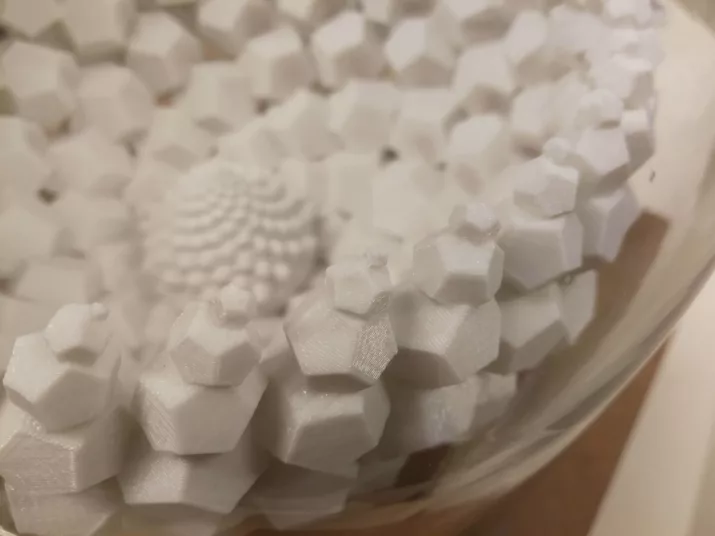
Photo: Robert Richter
Our Greatest Role Model
Nature structure
The wealth and diversity of nature inspire awe. Ancient redwood trees, brightly coloured blooms, clever camouflage… The sheer complexity created through evolution is truly astonishing. No less astonishing, however, is that much of evolution relies on surprisingly simple mathematic principles. Dr. Robert Richter finds this fascinating. He invites us to explore the world with open eyes and discover the maths inside honeycombs, snowflakes, and spiderwebs, or even in the grocery store aisles. With his three interactive exhibits at the Futurium Lab, Richter wants to highlight the efficiency of nature, the principles behind it, and what we can learn to shape our own future.

Photo: Robert Richter
Repeat after me
Based on his explorations of nature, Richter devises experiments at the Technical University of Berlin designed to get non-scientists excited about maths and natural sciences. “All of these phenomenal colours, shapes, and patterns around us are the results of natural processes. Often, they are far more spectacular than anything artists could even dream of. Take for example crystals: by reordering their atoms, you get a wealth of different geometric structures ranging from cubes and prisms to dodecahedrons and some other really crazy shapes.
But things get really interesting with plants. The key geometric principles like the Golden Ratio and Golden Angle can be found absolutely everywhere. Why? Because evolution favoured the most efficient species that followed exactly these principles.” They are based on mathematic repetition. Robert Richter’s first of three installations at the Futurium is a great example. It draws our attention to the widespread ‘self-similarity’ in nature.
Strobe-lit enlightenment
For his Futurium exhibit, Richter took inspiration from the American artist John Edmark whose collection of ‘Blooms’ conjure up beautiful optical illusions from simple mathematic principles. If you want to know more about how these mesmerising, spiralling patterns work in art and nature, we recommend this video on the subject. Just like Edmark’s Blooms, Richter’s own plastic sculptures resemble generous blossoms with a self-similar structure. The unique twist: they spin around their own axis at lightning speed and are illuminated by flashes of strobe light at every 137.5-degree turn (the aforementioned Golden Angle).
The interplay of movement and light creates an astonishing visual effect. Like computer animations, Richter’s Blooms seem to mingle and merge. When visitors change the strobe speed, the animation also seems to slow down or speed up and we see double or multiple images. “The way the Blooms work is similar to the zoetropes at county fairs a century or so ago. When spun up to speed, the pictures inside the moving drums would turn into a short film. At a certain speed, our brain interprets the separate images as fluid movement.”
Why does the leopard have spots?
And what about the zebra’s stripes? Robert Richter’s second experiment shows how calculating nature can be in other areas. Step by step, a few simple rules and variables (here: camera angle and zoom setting) create extremely complex patterns that resemble the hide of a giraffe or the patterns on a puffer fish. Richter needs only an empty screen and a camera. Since the monitor displays the camera’s image, pointing the camera at the screen creates a closed loop.
For the desired effect, Richter has set up the camera at a slight angle. This simple feedback process lets visitors see in real time how familiar natural patterns emerge through continual repetition of the same rules. Even tiny changes to the angle or zoom setting will change the results and lead to, for example, zebra stripes or leopard spots. Visitors can try their own hand at designing nature and creating brand new patterns.
Painting by numbers
Photo: Robert Richter
If you prefer to tinker yourself, use one of Richter’s spirographs to experience the ubiquity of the Golden Angle. Richter’s drawing devices create mathematic curves that resemble natural blossoms. Once again, each ‘petal’ is staggered by the familiar degree of 137.5 and automatically ends up in the bloom’s largest remaining gap, just like in nature. The more gears you add to the spirograph, the closer the you get to the Golden Ratio. This is an excellent way to get a feel for the efficiency and precision of nature, even when it looks wild and spontaneous.
Photo: Robert Richter
Join the fun
Ready to try this at home? According to Richter, it’s easy enough to set it up on your own. “All you need for the video feedback is a monitor and a camera. It works even better with old TVs that have no built-in image correction. I’d also recommend checking whether your city has a Fab Lab or Maker Space. They’ll help you use a laser cutter or 3-D printer for your own projects.” No strobe light in sight? Then recreate the Blooms principle with a DIY zoetrope. Anyone who’d like to delve deeper into the fascinating realm of fractal (self-similar) geometries should really check out the ‘fractivities’ of the Fractal Society.
The future is analogue
Researchers and developers agree: you can’t really beat the efficiency of nature. What has taken natural selection millions of years to streamline and perfect can rarely be improved upon, and is rather worth copying. Improved lighting, rock solid construction, and the efficient use of materials: the mathematic principles of self-similarity, the Golden Angle, and the evolution of structures not only help architects build better homes, but also hint at intriguing alternatives to digital technologies.
According to Richter, “the video feedback works like an analogue computer. The images and changes are not the result of digital computation based on ones and zeros, but the product of simple, tangible parameters, in our case, zoom setting and camera angle. Experts already believe that in the future, such analogue computers will help us solve far more complex problems, especially to calculate probabilities."